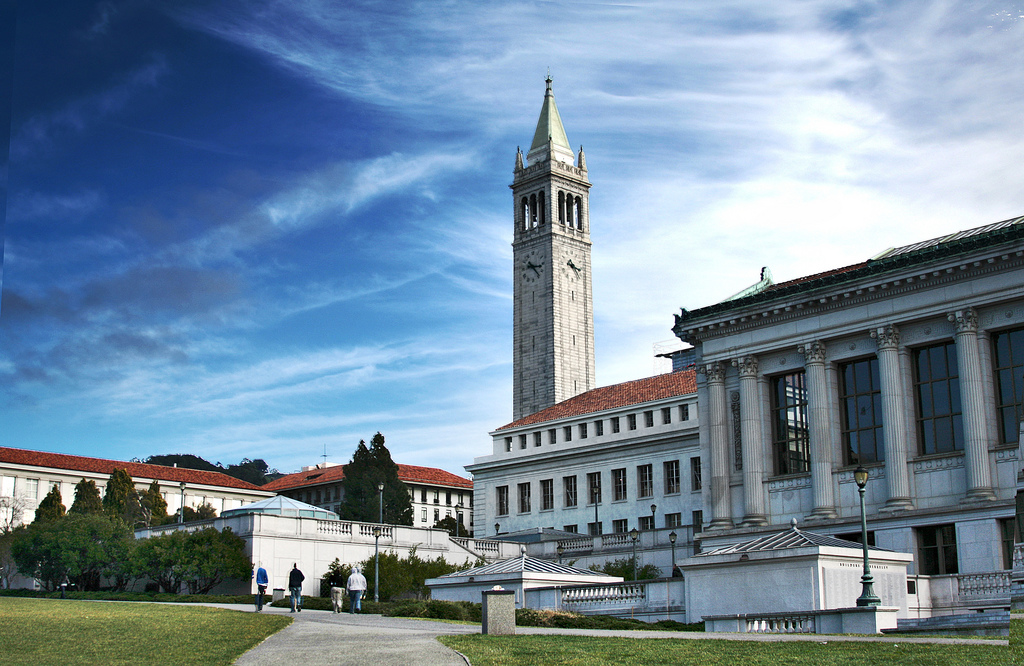The question of how Asian Americans are impacted by affirmative action was a major topic of discussion earlier this year with the fight over SCA-5, and has returned with the filing by conservative partisan Edward Blum’s two lawsuits against Harvard and University of North Carolina – Chapel Hill seeking to end affirmative action on the basis that it discriminates against Asian American applicants.
The problem with Blum’s assertions are that he argues that the vast majority of Asian Americans oppose affirmative action (not true), and that all Asian Americans are currently directly disadvantaged by affirmative action policies (also not true). This latter point merits additional consideration: whereas Blum’s lawsuit treats Asian Americans as a monolithic group of high-achievers, the reality is that the AAPI community includes a broad range of Asian and Pacific Islander ethnic groups spanning a spectrum of income and educational opportunities. Yet, the specific needs of these (predominantly non-East Asian) ethnic groups are typically ignored by anti-affirmative action groups.
It is pretty much settled fact that well-represented Asian American students enjoyed high admission and enrollment rates at public universities such as the University of California (UC) system under race-conscious affirmative action, and that these admission and enrollment rates remained largely stable for most of the time after its abolishment; these data indicate that in the aggregate, race-conscious affirmative action hasn’t really impacted Asian American admission at the University of California. At elite schools such as Harvard University, Asian Americans are similarly well-represented at nearly four times our national demographic percentage — a fact that is included in Blum’s lawsuit as well as in many other sources.
However, is there an effect of affirmative action when Asian Americans are disaggregated by ethnic group? Specifically, does race-conscious affirmative action produce an observable benefit to Southeast Asian American enrollment for example? Conversely, does the absence of race-conscious affirmative action hurt Southeast Asian American applicants?
In 1998, Filipino Americans were included in a class-action lawsuit against UC Berkeley charging that removal of race-conscious affirmative action policies violated antidiscrimination laws designed to protect secondary education access for underrepresented minorities.
To date, analysis of Filipino American admission and enrollment has been lacking, leading to some disagreement as to whether or not Filipino Americans are actually underrepresented in UC schools. For example, whereas absolute enrollment of Filipino Americans were reported as low and decreasing in one infographic by Asian Americans Advancing Justice, Byron Wong reported in his podcast with me that an unnamed source had emailed him some uncited data showing that Filipino Americans were not underrepresented on UC campuses.
Today, I decided to analyse data published by the UC system to resolve these inconsistencies in findings. I focus on Filipino Americans because it is the only Southeast Asian American group for whom disaggregated data are available without submitting a Freedom of Information request. The question we are asking: are Filipino Americans underrepresented at University of California schools?
If we consider all students enrolled in all campuses in the statewide UC school system, we see that — unlike Black students (shown) or Latino, Chicano or American Indian students (not shown) — Filipino American students are not underrepresented. However, Filipino American students are also not overrepresented, as Chinese American students are by a factor of five relative to their state-wide demographics. Not shown are Korean American students who are overrepresented by a factor of four, and Japanese American students who are overrepresented by a factor of 1.5.
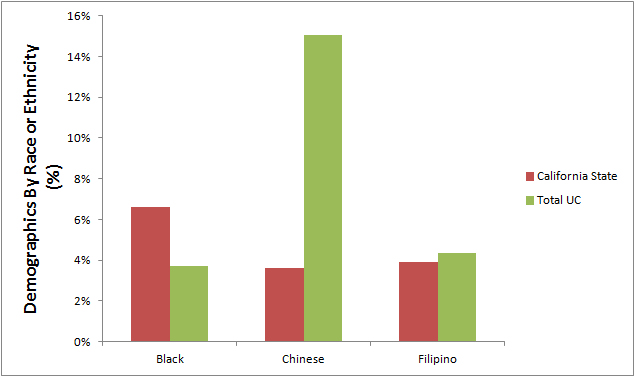
These data seem to suggest that Filipino American students in the absence of affirmative action are not encountering substantial obstacles in accessing a secondary education in the UC school system. However, what about the type of campus they have access to?
Here’s where things get interesting.
As Oiyan Poon (@spamfriedrice) reminded me, the UC school system should really be considered “one university with ten campuses”, but also that the different campuses are different in terms of their selectivity. While some campuses — UC Riverside, for example — is considered broadly accessible and admits 61% of applicants, UC Berkeley tops the list as the most selective of the campuses with an admission rate of only 18%.
It’s worth also noting that UC Berkeley also ranks in the top 5 of public universities, whereas UC Riverside is ranked 46th by US News & World Reports, so (if you’re someone who thinks that these school rankings are meaningful when it comes to the quality of education) there is a clear distinction between admission to UC-Berkeley vs. UC-Riverside.
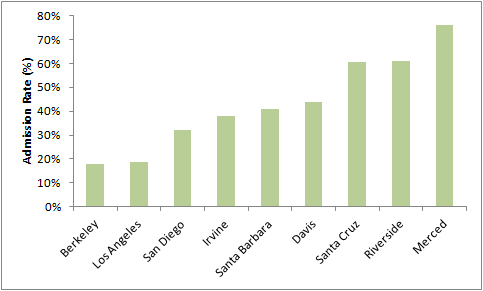
It turns out that in the absence of race-conscious affirmative action, Filipino Americans are being shut out of some of the “elite” UC campuses. At UC Berkeley, Filipino Americans — like Black and other underrepresented minority students — are significantly underrepresented, whereas Chinese American students (like other East Asian Americans) are well-represented. Instead, it seems that the majority of Filipino American students in the UC system are receiving admittance mainly to the more broadly accessible campuses such as UC Riverside, which admits nearly two thirds of applicants in general.
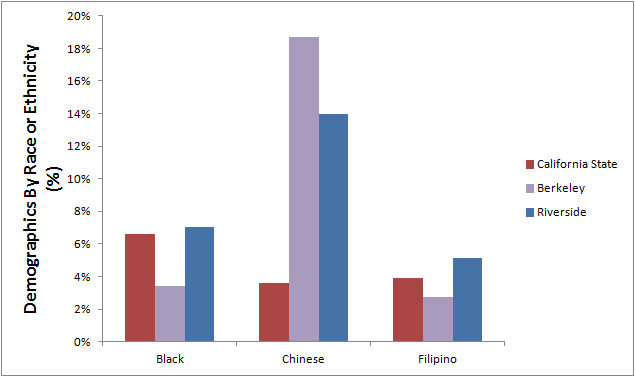
Filipino American students are similarly underrepresented (relative to statewide demographics) at UC-Santa Barbara and UC-Santa Cruz, and are even slightly underrepresented at UC-Los Angeles, the second most selective campus in the UC system.
Put another way, the admission rate for Filipino Americans is significantly lower than the average for all Asian American students: 75% of all Asian American students receive admittance to a UC campus compared to 59% of Filipino American students. This disparity is exacerbated at selective schools such as UC Berkeley, where the admittance rate for Filipino American applicants is less than half that of the rest of its Asian American applicants.
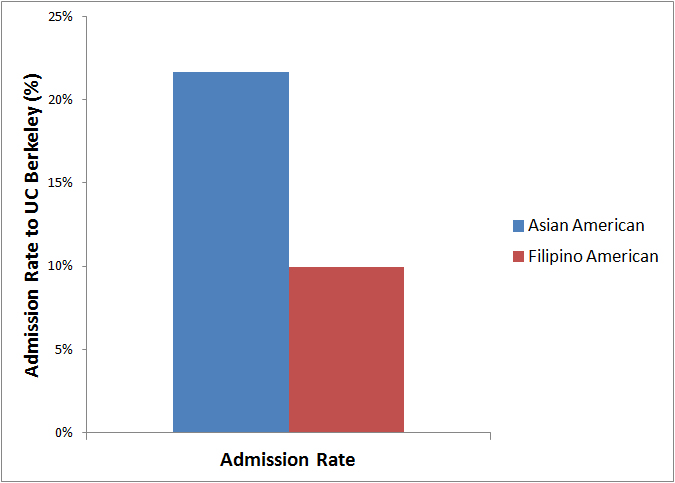
With race-conscious affirmative action in place, the admission rate for Filipino Americans to UC Berkeley was on average 25.7% between 1989-1997 (and was on average 34% prior to 1991, after which changes in admissions policies negatively impacted Filipino American applicants prior to the full elimination of affirmative action). However, with the end of affirmative action thanks to Proposition 209, Filipino American admission rates dropped to an average of 19% (vs. 27% for all Asian Americans) between 1998-2010. J.Y. Okamura argues that this decrease may have been more severe had there not been a concerted effort in this period by Filipino American students to recruit and retain incoming Filipino American freshmen.
The current admission rate of 9% for Filipino American students applying to UC Berkeley reflects the combined disadvantage to these applicants associated with the elimination of race-conscious affirmative action policies, as well as recent state-wide budget cuts to UC schools that has reduced admission rates across the board.
Thus, while Filipino American students are not underrepresented in the absence of race-conscious affirmative action when the UC school system is studied as a whole, they are most certainly underrepresented when specific campuses are considered.
The purpose of this post is not to pit Chinese American students against Filipino American students (nor to suggest that there is something innately maligned about East Asians being well-represeted at these campuses), but rather to offer a more nuanced view of how affirmative action is impacting students of different ethnicities within the AAPI diaspora by providing disaggregated data that paint a very different picture of how some Asian Americans and Pacific Islanders might be influenced by the current admission policies of the UC system. In our ongoing conversation about Asian Americans and affirmative action, we simply must stop universalizing the narratives of some Asian Americans — typically Chinese Americans — as if they represent the narratives of all AAPI.
Instead, we need to add sophistication to the conversation. There are some AAPI who are well-represented in the UC school system, and for whom the absence of race-conscious affirmative action has done little to shift their admission numbers. But there are also other AAPI — in this case Filipino Americans — who remain quite underrepresented within certain parts of the UC school system. The data in this post demonstrate quite clearly that Filipino Americans are being excluded from selective campuses within the UC school system — and instead shunted towards the more broadly accessible campuses — in a manner that can be directly attributable to the elimination of Proposition 209.
In our zeal to discuss how Asian Americans are impacted by affirmative action — positively or negatively — let us not erase the voices of these AAPI. We are not all the same; we have not all been impacted in the same way; we need to stop letting affirmative action opponents such as Edward Blum treat us like we are all the same.
Act Now! Please sign this petition opposing Edward Blum’s recently filed lawsuits that purport to speak for the Asian American community while seeking to end affirmative action, and tweet your support to the hash-tag #BlockBlum.
